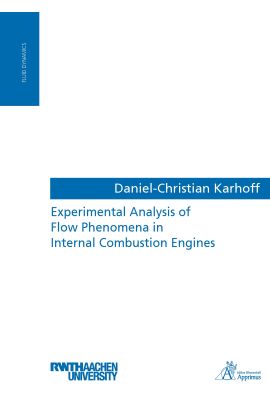The air-fuel mixing and hence the efficiency of the combustion process of piston engines is strongly influenced by the small and large scale flow structures that evolve during the intake and compression strokes. This study investigates the non-reacting flow during these first two strokes of the optical demonstrator engine TINA using particle-image velocimetry (PIV). The influence of the intake port geometry is analyzed by comparing the flow structures of the TINA engine with its tumble port with those of the SUZI engine, which has an intake port design optimized for high filling. The ensemble-averaged flow fields, and the temporal evolution of the ensemble- and plane-averaged mean and turbulent kinetic energies and the ensemble- and plane-averaged vorticity show that the very well conserved tumble vortex dominates the flow structure in the TINA engine during intake and compression, which is caused by the intake port transporting rotating flow structures into the combustion chamber. The influence of the tumble vortex in the SUZI engine, where the tumble is generated within the combustion chamber, is significantly smaller. An analysis of the impact of a non-uniform density distribution is carried out by aspirating argon through one intake port instead of ambient air. The argon intake jet decelerates less rapidly than the air intake jet, which is due to the argon jet's higher inertia. This leads to a higher amount of mean kinetic energy in the intake stroke. Accordingly, the level of turbulence production in the free shear layers of the argon jet is higher due to the higher flow velocities of the jet. An investigation of cyclic variations is carried out by analyzing the path of the tumble vortex core, the temporal development of the mean and turbulent kinetic energy, and by a POD analysis. The path of the tumble vortex core differs significantly between individual cycles. The same applies to the temporal development of the mean and turbulent kinetic energies, where the data in individual cycles is well in excess of the standard deviation. A proper orthogonal decomposition of the flow field shows that the intake jets are the dominating flow structures in the intake stroke at crank angles smaller than 60° atdc. Thereafter, the tumble vortex forms and dominates the flow regime, and stabilizes during the compression stroke. At the end of compression, the first POD mode drops rapidly, indicating an energy transfer to higher modes and tumble vortex breakdown.
| Autor | Karhoff, Daniel-Christian |
|---|---|
| Lieferzeit | 3-4 Tage |
| Gewicht | 0.2 kg |
| Erscheinungsdatum | 12.11.2014 |
Eigene Bewertung schreiben
Strömungslehre
Experimental Analysis of Flow Phenomena in Internal Combustion Engines
ISBN: 978-3-86359-264-6
Lieferzeit: 2-3 Tage
39,00 €
inkl. 7% MwSt.
Kurzbeschreibung
Das Strömungsfeld innerhalb des Brennraums eines optischen Forschungsmotors ist stark durch den Tumblewirbel geprägt. Ein generisch erzeugter, höherer Dichtegradient führt zu einer höheren mittleren und turbulenten kinetischen Energie während der Ansaugphase. Der Weg des Tumblezentrums, der zeitliche Verlauf der mittleren und turbulenten kinetischen Energie sowie eine Hauptkomponentenanalyse lassen vor allem gegen Ende der Kompressionsphase zyklische Schwankungen erkennen.
Auf Lager

